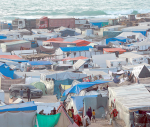You are here
The climate crisis is also a health crisis
Dec 05,2022 - Last updated at Dec 05,2022
By Seth Berkley and Werner Hoyer
GENEVA — The latest Lancet Countdown report, which monitors the health consequences of climate change, highlights the need to prepare for future calamities. Even as COVID-19 continues to spread, a recent study suggests that the likelihood of another pandemic increases by 2 per cent each year. In the coming decades, the interplay between the climate crisis and public health could create a perfect storm of global devastation and disruption.
The good news is that if we take immediate steps to transform our health systems, we can avert another COVID-style catastrophe. As with the current pandemic, the obstacles to mitigating climate change are not just scientific or technological, but also rooted in geopolitics and market forces. Self-interest can undermine public health, particularly when it comes to equitable access to resources. Even so, the international community came together to introduce innovative mechanisms like the COVID-19 Vaccine Global Access facility (COVAX), which was designed to remove the financial barriers that prevented lower-income countries from obtaining vaccines.
We must launch similar mechanisms for addressing the global public-health impact of climate change. While we already know many of the likely solutions, their effectiveness requires that we put them in place before disaster strikes. This is not just a moral imperative; it is also a smart economic choice that would likely reduce the overall cost of outbreaks and other climate-related catastrophes.
The United Nations Climate Change Conference (COP27) in Egypt this past November underscored the fact that sustainability is not just about decarbonisation, electric vehicles, or climate-adaptation measures such as flood defences. It is also about pandemic preparedness. More broadly, climate change is expected to shift the habitat range of deadly pathogens, causing infectious, mosquito-borne diseases like malaria, yellow fever and dengue fever to spread as far as northern Europe and Canada. At the same time, the climate crisis threatens to increase the prevalence of malaria, cholera, and schistosomiasis across the developing world.
The world’s poorest countries remain the most vulnerable to climate change, despite contributing the least to creating the problem. That is why the international community must take immediate steps to ensure that impoverished, marginalised communities have access to vaccines, treatments, and diagnostics. Given the devastating impact that a single virus has had on billions of lives, livelihoods and the global economy over the past three years, it is abundantly clear that we must urgently take steps to counter climate-related health threats.
The global effort to ensure equitable distribution of COVID-19 vaccines provides a useful model. The Gavi COVAX Advance Market Commitment, a financial mechanism funded by donors and accelerated by the European Investment Bank, enabled people in the world’s 92 poorest countries to obtain free vaccines. These lower-income countries, representing roughly half of the world’s population, would have struggled to secure access otherwise.
So far, more than 1.6 billion COVAX doses have been delivered to developing countries, helping to ensure that 52 per cent of their citizens are fully vaccinated, compared to a global average of 64 per cent. This is a remarkable achievement, particularly in the context of intense vaccine hoarding by developed countries, the export restrictions that some countries placed on vaccines and the components needed to produce them, and the actions of some manufacturers that have seemingly prioritised profit over fairness.
The COVAX model’s success shows that there is scope for similar innovative financing solutions to climate-related health risks. For example, several private-sector actors are currently exploring a Climate Advance Market Commitment to stimulate innovation and investment in climate solutions. Similarly, there is great potential for mechanisms based on the model of the International Finance Facility for Immunization, which uses dedicated “vaccine bonds” to frontload long-term donor commitments so that funds can be made available immediately.
Multilateralism is essential to establishing these safety-net mechanisms. COVAX was possible only because it united the financial firepower and knowhow of more than 190 governments, along with private-sector partners, civil-society groups and international agencies, around a common cause that benefited everyone. But if COVAX had already existed before the pandemic, equipped with at-risk contingency financing and surge capacity, it could have mounted its response, the world’s largest and most complex global deployment of vaccines ever, even faster, ultimately saving more lives.
Following COP27, donor governments and multilateral lenders must examine how existing financial mechanisms could be adapted to the fight against climate change to guarantee that funds are made available as soon as a threat emerges. Minimising the overall financial costs of climate-related health risks involves not just prevention but also early action. These safety-net mechanisms should also be designed to protect the world’s most vulnerable people, wherever they live.
But what matters most is that these steps are taken now. As The Lancet report warns, the countdown to the next global health crisis has already begun.
Seth Berkley is CEO of Gavi, the Vaccine Alliance. Werner Hoyer is president of the European Investment Bank. Copyright: Project Syndicate, 2022. www.project-syndicate.org













